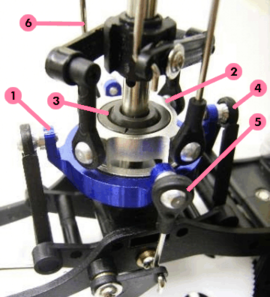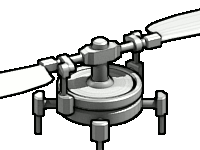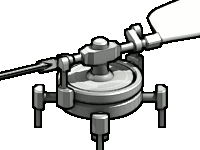Bruger:Necessary Evil/Styreplade
En styreplade[1] (swashplate) overfører bevægelser af pilotens styregrejer (cyclic og collective stick) til hovedrotorens blade. Styrepladen er nødvendig fordi hovedrotorbladene snurrer rundt og resten af helikopteren ikke gør det.

1 Nederste stationære styreplade (blå)
2 Øverste roterende styreplade (sølv)
3 Kugleled
4 Styrekontrolstang (pitch)
5 Styrekontrolstang (roll)
6 Kontrolstang til rotorbladet
Assembly[redigér | rediger kildetekst]
The swashplate consists of two main parts: a stationary swash plate and a rotating swash plate. The stationary (outer) swash plate is mounted on the main rotor mast and is connected to the cyclic and collective controls by a series of pushrods. It is able to tilt in all directions and move vertically. The rotating (inner) swash plate is mounted to the stationary swash plate by means of a bearing and is allowed to rotate with the main rotor mast. An anti-rotation link prevents the inner swash from rotating independently of the blades, which would apply torque to the actuators. The outer swash typically has an anti-rotation slider as well to prevent it from rotating. Both swash plates tilt up and down as one unit. The rotating swash plate is connected to the pitch horns by the pitch links. Alternative mechanics to the stationary (outer) swash plate are the hexapod and the universal joint. Swashplates for helicopters having two rotors mounted on the same shaft are much more complex than the single rotor helicopters.
Cyclic blade control[redigér | rediger kildetekst]
Cyclic controls are used to change a helicopter's roll and pitch. Push rods or hydraulic actuators tilt the outer swash in response to the pilot's commands. The swashplate moves in the intuitively expected direction, tilting forwards to tilt the rotor "disc" forwards, for instance, but "pitch links" on the blades transmit the pitch information ahead of the blade's actual position, giving the blades time to "fly up" or "fly down" to reach the desired position. This creates a difference of lift around the blades, and the helicopter will tilt towards the side with lower lift.
Collective blade control[redigér | rediger kildetekst]
To control the collective pitch of the main rotor blades, the entire swashplate must be moved up or down along its axis without changing the orientation of the cyclic controls. Conventionally, the entire swashplate is moved along the mainshaft by a separate actuator. However, some newer model helicopters remove this mechanically complex separation of functionalities by using three interdependent actuators that can each move the entire swashplate. This is called cyclic/collective pitch mixing.
Animations[redigér | rediger kildetekst]
-
Styrepladen i neutral position.
-
En løftet styreplade ændrer rotorbladenes indfaldsvinkel kollektivt. Bemærk at kontrolstængerne her er på bladenes bagkanter, så en løftet styreplade får denne helikopter til at synke.
-
En skrå styreplade ændrer konstant rotorbladenes indfaldsvinkel under rotationen.
History[redigér | rediger kildetekst]
Originally, the swashplate was invented by Boris Yuryev in 1910.[2] Today, on most modern aircraft the swashplate is above the transmission and the pushrods are visible outside the fuselage, but a few early designs, notably light helicopters built by Enstrom Helicopter, placed it underneath the transmission and enclosed the rotating pushrods inside the mainshaft. This reduces rotor hub drag since there are no exposed linkages.
Other swashplate and control design have been used. For instance, Kaman Aircraft helicopters do not use a traditional swashplate and instead operate servo flaps on the rotor blades to adjust the angle of attack of the blades.



